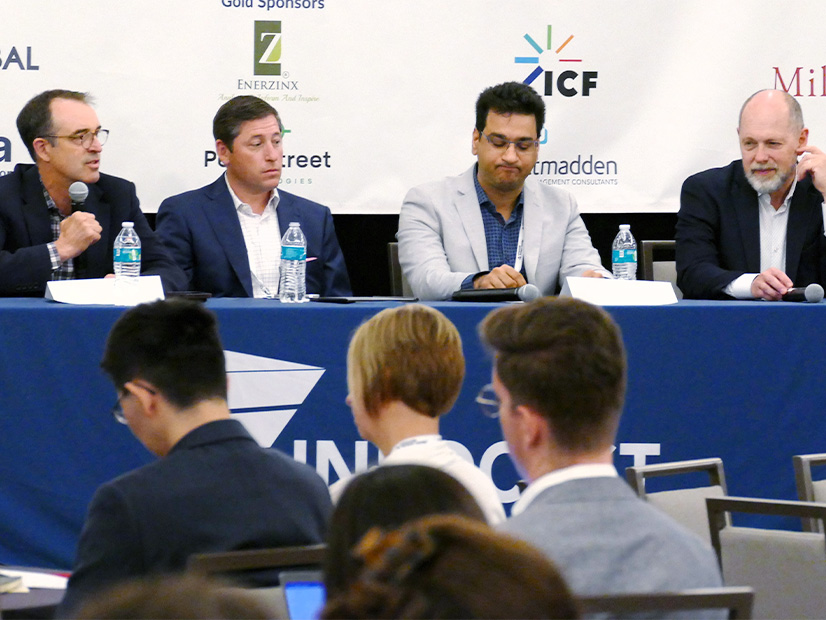
ARLINGTON, Va. — FERC Order 1920 could help move the ball significantly on more efficiently expanding the transmission grid, but its ultimate success depends on how it and other policies are implemented.
Grid Strategies President Rob Gramlich told attendees of Infocast’s Transmission & Interconnection Summit on June 26 that Order 1920 is the biggest energy policy the U.S. has seen since the Inflation Reduction Act. Getting planners focused on lines with clear benefits and allocating costs to those who receive those benefits should help get transmission built, he said.
“Order 1920 really does that in a very well-crafted way,” Gramlich said.
But a big part of the order’s success will depend on how it is implemented, Gramlich said. Some areas, such as CAISO and MISO, already largely do what FERC has directed, but some regions lack any history with the kind of long-term planning Order 1920 envisions.
“I think the biggest industry challenge now is to get consensus with states and those other stakeholders to get busy doing it, figuring out who’s going to do it and how,” Gramlich said.
Order 1920 builds on earlier FERC orders, most directly Order 1000, which tried to set a floor for regional and interregional planning more than a decade ago but fell short on implementation.
“I think what we’ve seen in the West in the past with implementation of FERC Order 1000 is that the utilities convert that floor into a ceiling in their compliance filings, and it becomes sort of a straitjacket to doing innovative transmission planning,” Maury Galbraith, executive director of the Colorado Electric Transmission Authority, said during a webinar hosted by Advanced Energy United last week.
Galbraith argued that in planning processes under the new rules, utilities should not be allowed to use their FERC-regulated tariffs as a way to get out of running scenarios requested by other stakeholders.
Even if Order 1920 is perfectly implemented, the transmission expansion many say is needed to meet rising demand and connect new sources of supply still will need other policy changes, said Patrick Bond, senior policy adviser for Sen. Angus King (I-Maine).
“The biggest concern I have is going to be permitting: Even if there’s a plan, and cost allocation is all approved, and you don’t have lawsuits or anything like that, we’re still going to have siting and permitting challenges,” Bond said at the Infocast event. “And I think that those still need to be addressed.”
Congress has given the federal government the ability to overrule states that reject transmission lines in National Interest Electricity Transmission Corridors (NIETCs), for which FERC issued rules to implement its share of that process with Order 1977 simultaneously with 1920. But the U.S. is going to need more new transmission lines than the NIETC process can handle, Bond said.
King is a member of the Senate Energy and Natural Resources Committee, whose leaders from both parties have been working on a bill to update U.S. permitting laws. While any legislation is difficult to pass, permitting is an issue that is holding back other policy preferences, Bond said, so there could be bipartisanship.
The chances of passing a major bill in 2024 are not that great, as just six weeks are left with Congress in session before the election. There also is a lame duck session after the election. Gramlich said energy-related items could be included in vehicles that are likely to move in 2025, with the need to pass a budget and the individual income tax cuts under the Tax Cuts and Jobs Act of 2017 expiring at the end of that year.
Politics overlays a lot of the issues, and while Gramlich argued that the rhetoric does not line up with Order 1920’s requirement that only beneficiaries of transmission lines pay their fair share of the costs, others were less optimistic.
“I think the landmine here is that somehow 1920 is a partisan issue,” Grid United President Kris Zadlo said at the Infocast conference. “And I think energy security is national security. And we need to think about it from that mindset.”
Industry needs to work quickly to accommodate the rapid growth in load in many parts of the country, he added. A 7% annual growth rate means that in just five years, demand grows by 50% overall, Zadlo said.
Much of the political blowback on Order 1920 is coming from states. Many of them filed for rehearing, essentially asking FERC to go back to the drawing board.
But Michigan Public Service Commission Chair Dan Scripps said on the AEU webinar that many did not. The two RTO-wide state regulator groups the PSC belongs to (the Organization of MISO States and the Organization of PJM States Inc.) asked for some clarifications, but they did not seek rehearing on the bulk of the order.
“We may have differences among the states around whether or not FERC should have done this, but now that they have, how do we ensure compliance?” Scripps said.
The order directs transmission providers, including ISO and RTOs, to give states in their footprints six months to come up with cost allocation rules, but it stops short of requiring them to file them with the commission as an alternative proposal. That is one area Scripps would like to see changed on rehearing. OPSI and other parties made similar requests in their filings.
“I do think that where states can come together and agree on an approach … there should be a requirement that that at least gets filed and considered and not ignored,” Scripps said.


